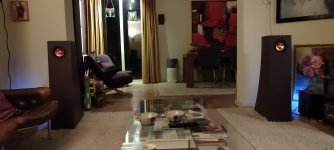Here are DIY Decker Headwreakers. Very nice vintage sound. Powered by Decware UFO84 SET but soon to have Elkit TU-8400 for more punch.

My chn110 speakers with 31 Liter volume. Fb at 35 Hz . A ported speaker with the port deliberately mounted high up, in the back of the speaker to avoid exciting the room.
Each opposite wall is thicker ( i.e. 19mm and 22mm ) to avoid any tunefork colorations ( different resonance frequencies ) and relieve the possibly bad influence of an MDF cabinet.
Comparisons with Genelec 8030C and my 8340 SAM monitors made me sell my Genelecs.

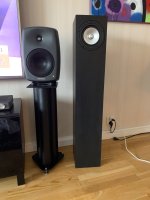

Each opposite wall is thicker ( i.e. 19mm and 22mm ) to avoid any tunefork colorations ( different resonance frequencies ) and relieve the possibly bad influence of an MDF cabinet.
Comparisons with Genelec 8030C and my 8340 SAM monitors made me sell my Genelecs.


Hi
In all the boxes I have tried the CHN-110 with I have always found excess bass, only with Dave's CGR CHN-Ken110s 0v82 (they are public design boxes) have I found balance in all frequencies.
If I could, I would like to see your box design and be able to clone it.
Thanks in advance,
Jose Luis.
@Audientid14
.In all the boxes I have tried the CHN-110 with I have always found excess bass, only with Dave's CGR CHN-Ken110s 0v82 (they are public design boxes) have I found balance in all frequencies.
If I could, I would like to see your box design and be able to clone it.
Thanks in advance,
Jose Luis.
What is your room like and what boxes for CHN110 have you tried?In all the boxes I have tried the CHN-110 with I have always found excess bass, only with Dave's CGR CHN-Ken110s 0v82 (they are public design boxes) have I found balance in all frequencies.
You have PMHi
@Audientid14
.
In all the boxes I have tried the CHN-110 with I have always found excess bass, only with Dave's CGR CHN-Ken110s 0v82 (they are public design boxes) have I found balance in all frequencies.
If I could, I would like to see your box design and be able to clone it.
Thanks in advance,
Jose Luis.
Hi guys. This continuation of #5404/5406 may be my thousandth message here (hard to believe) all in a short span of two-plus years. I finally squeezed in a few hours of experiment & trials in order to extend the reflector-coaxial virtual point-source to multiple-tweeter configurations. I don't know if the tweeters' reflected acoustic centers are quite within 1/4 wavelength <1cm of very high frequency >10khz, but they should be closer than front-firing tweeters. I evaluated the "speaker" by listening to music and 10.5khz sinewave -- hovering over the speaker maintaining distance and (crucially) ear-angle to the dustcap. I video-recorded high violin music with a smartphone, while slowly arching acrobatically over an imaginary hemisphere maintaining mic-to-dustcap relative position/angle as much as possible. I also recorded music on-axis and off-axis ~30/60deg, and as a "control" the same with tweeters facing away from the dustcap i.e. no bounce. Tentative conclusions given limited time:
o Comb-filtering was not heard near-field with tweeters configured as shown, arrived at through trial-and-error. (Shadowing by a lone-tweeter or double-tweeter possible, if listening directly behind.) I have not analyzed the recordings for comb-filtering well above my hearing.
o As long as the dustcap is fully within view unobstructed, high frequency is not noticeably attenuated. As the dustcap goes beneath the cone's rim-horizon, tonality change is noted.
o Playing single speaker/channel, the violin sound (image) comes from a well-defined location far beyond the speaker. The control with tweeters facing out lost this imaging ability (I did not have time to try tweaking phase).
o The control's high frequency may have been a little louder but did not sound more detailed or brighter.
o The best imaging during this trial (again, constrained by time) happened with the speaker off to one side firing up, myself seated (as in #5404) looking straight ahead, not at the speaker.
o Suggested positioning of 1-3 tweeters for normal front-facing left speaker is as shown, i.e. gap to the right. If up-firing, gap toward the listener.
o 15" drivers used: with 3 B&O tweeters, 97dB-sensitivity JBL 2226H original cone but otherwise unvouched-for condition (great sound); with 2 Celestion high-sensitivity tweeters, 100dB Peavey Black Widow 1505DT-8 (limited trial). Used Pro/PA monster drivers are dime-a-dozen but condition is not assured except by picture/videoclip, maybe.
o If up-firing, woofer can run straight-through and tweeter cap-filtered, though both 1st-order probably still better.
I'll name this wide-dispersion virtual point-source design series PrimeRadiant, as in meteor shower center of origin (and Asimiv gadget).
Hope someone gives it a try.




o Comb-filtering was not heard near-field with tweeters configured as shown, arrived at through trial-and-error. (Shadowing by a lone-tweeter or double-tweeter possible, if listening directly behind.) I have not analyzed the recordings for comb-filtering well above my hearing.
o As long as the dustcap is fully within view unobstructed, high frequency is not noticeably attenuated. As the dustcap goes beneath the cone's rim-horizon, tonality change is noted.
o Playing single speaker/channel, the violin sound (image) comes from a well-defined location far beyond the speaker. The control with tweeters facing out lost this imaging ability (I did not have time to try tweaking phase).
o The control's high frequency may have been a little louder but did not sound more detailed or brighter.
o The best imaging during this trial (again, constrained by time) happened with the speaker off to one side firing up, myself seated (as in #5404) looking straight ahead, not at the speaker.
o Suggested positioning of 1-3 tweeters for normal front-facing left speaker is as shown, i.e. gap to the right. If up-firing, gap toward the listener.
o 15" drivers used: with 3 B&O tweeters, 97dB-sensitivity JBL 2226H original cone but otherwise unvouched-for condition (great sound); with 2 Celestion high-sensitivity tweeters, 100dB Peavey Black Widow 1505DT-8 (limited trial). Used Pro/PA monster drivers are dime-a-dozen but condition is not assured except by picture/videoclip, maybe.
o If up-firing, woofer can run straight-through and tweeter cap-filtered, though both 1st-order probably still better.
I'll name this wide-dispersion virtual point-source design series PrimeRadiant, as in meteor shower center of origin (and Asimiv gadget).
Hope someone gives it a try.
Last edited:
Don't know if people can figure out how to play the videos on bilibili (China's youtube) -- maybe just keep pressing. Lossy compression, sorry.
Extreme violin whistling folktune repeated ~60° off-axis; on-axis; ~30° off-axis https://b23.tv/ljcMPBf
Same, hemisphere-hovering https://b23.tv/Fa4CFV0
Violin showpiece in the style of Central Asia, hemisphere-hovering https://b23.tv/wudKgCx
(The same two pieces I recorded for the single tweeter reflector "Axia")
Extreme violin whistling folktune repeated ~60° off-axis; on-axis; ~30° off-axis https://b23.tv/ljcMPBf
Same, hemisphere-hovering https://b23.tv/Fa4CFV0
Violin showpiece in the style of Central Asia, hemisphere-hovering https://b23.tv/wudKgCx
(The same two pieces I recorded for the single tweeter reflector "Axia")
I'm attempting a couple of videoclip uploads to China's youtube. Please let me know whether & how well they play.
https://www.bilibili.com/video/BV12JtoeeEgg/ (short Extreme violin, from CD-rip, "reflector-coaxial" distance ~1m) "Reminiscing"
https://www.bilibili.com/video/BV1KptoeYETq/ (longer showpiece, from CD-rip, "reflector-coaxial" distance ~1m) "Sunshine..."
Taken with inexpensive smartphone so please EQ/rebalance if you want to enjoy the music. For test evaluation only. (Bass falls off gradually below 230hz due to well-damped nested washbasins.)...
https://www.bilibili.com/video/BV12JtoeeEgg/ (short Extreme violin, from CD-rip, "reflector-coaxial" distance ~1m) "Reminiscing"
https://www.bilibili.com/video/BV1KptoeYETq/ (longer showpiece, from CD-rip, "reflector-coaxial" distance ~1m) "Sunshine..."
Taken with inexpensive smartphone so please EQ/rebalance if you want to enjoy the music. For test evaluation only. (Bass falls off gradually below 230hz due to well-damped nested washbasins.)...
... I also recorded music on-axis and off-axis ~30/60deg, and as a "control" the same with tweeters facing away from the dustcap i.e. no bounce. ...
Hi, sound from tweeter diffracts around for wavelengths longer than size of the tweeter. This means you always hear direct sound from the tweeter first, after which reflection from the cone enters ear, except for very high frequencies. Conversely, no matter which way the tweeter points at most of the bandwidth will bounce from the woofer cone, all wavelengths ~longer than diameter of the tweeter, no matter which way the tweeter points at. Only frequencies whose wavelength is shorter than the tweeter physical size are beamed. With a 1" only about 13kHz up the tweeter is directional, and below that sound reflects from the cone, and what enters ear is direct sound of the tweeter, before reflection from the cone comes in. So, when you flip the direction of the tweeter what you hear is changes above 13kHz, and of course time delay changes from the reflection as well as time delay of the tweeter and woofer.
edit. not quite as small difference as I wrote, here rough estimation of ideal 1" source sound toward front (0 deg) and toward back (180deg). Difference at ~10kHz is about 12db or so, at 5kHz it's about 6db or so already.
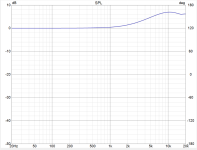
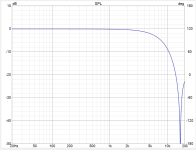
ps. sorry this is fullrange photogallery so not a good place to post stuff like this 😀 Anyway, happy holidays everyone!
Last edited:
Thanks for the reply, this is useful -- the intended bounce off of the dustcap is indeed the dominant HF, time-aligned with the woofer by the delay as designed (and heard as transcient/soundstage fidelity). Realistically, tweeters have casing/inset/surround/etc and are not so "ideally" undirectional.edit. not quite as small difference as I wrote, here rough estimation of ideal 1" source sound toward front (0 deg) and toward back (180deg). Difference at ~10kHz is about 12db or so, at 5kHz it's about 6db or so already.
Yeah this photo gallery is in the fullrange forum but WAW/FAST (supertweeter) are considered fullrange+, and the multi-way forum hasn't got a general purpose gallery! I think in spirit my two-year-long series of minimalist-XO/XO-less speaker experiments fit better here than over there -- maybe. As for being possibly too technical or wordy, well, figure captions are very important.
Last edited:
If the tweeter output is bouncing off the dust cap, would that double the "doppler" affect? Perhaps this could be used to our advantage, by using a very directional horn or ring tweeter, bounding several times between a driver and stationary reflector, magnifying the affect, allowing us to hear how it changes the sound.
You can play with this with ideal drivers and flat shapes in vituixcad. Make diffraction sim of ~1" source with ~1" baffle, then use the room tab "front wall" at say 10mm or 20mm or what ever is the distance from your driver to the cone, and look at the orange "in room graph", which now shows effect of direct sound and reflection of the frontwall, the woofer cone. Here the tweeter about 1cm away from the woofer cone, basically the tweeter housing touching the cone, tweeter ponting out.Thanks for the reply, this is useful -- the intended bounce off of the dustcap is indeed the dominant HF, time-aligned with the woofer by the delay as designed (and heard as transcient/soundstage fidelity). Realistically, tweeters have casing/inset/surround/etc and are not so "ideally" undirectional.
Yeah this photo gallery is in the fullrange forum but WAW/FAST (supertweeter) are considered fullrange+, and the multi-way forum hasn't got a general purpose gallery! I think in spirit my two-year-long series of minimalist-XO/XO-less speaker experiments fit better here than over there -- maybe. As for being possibly too technical or wordy, well, figure captions are very important.
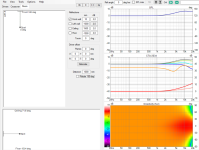
Now on main window you can just rotate the tweeter data 180deg to "point it at the woofer", source 1cm away from the woofer pointing at the woofer (wall). to see what's the rough difference when you do this.
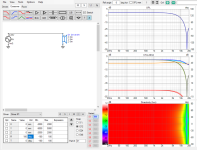
Here with 2cm distance:
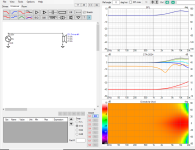
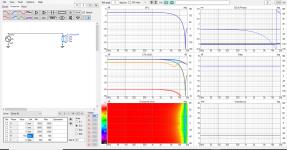
These have error, full 180deg DI calculation for example, although the tweeter is effectively at half space. Anyway, some examples if you want to play with this stuff in simulator to capture some of the underlying phenomenon. Reality is more complex than this, so you never get this clean results in reality. This makes the sims useful in my opinion, to be able to see very fundamental / basic interaction in isolation from all the ripple reality brings on top.
If only it did conic surfaces... spherical dustcap or simple omni reflector like the snow-cone below. The PrimeRadiants are effectively half-space omni-directional per tweeter on-axis FR.You can play with this with ideal drivers and flat shapes in vituixcad.
MAOP10 had been unavailable since Covid, until 11/1 pre-Singles Day. I snatched it and also China's first pair of MA200, which was HF-humped on-axis but very flat off-axis ~30-40° out to 15khz -- both listened-to as desktop-omni and confirmed using umik-1/REW. I was going to buy a spare MA200 until I heard the MAOP10. The "high-end" stainless-sandwich trash can hid a 1.5m tri-fold concentric TL (obviously unfinished and drivers far from run-in). Actually sounded rather like the first PrimeRadiant Axia but at 5X the cost. Anyway I clenched my teeth and bought a spare set.
Last edited:
p.s. Importantly, the snow-cone changed the distance of travel so reflected sound and direct sound from the driver were out of time/phase alignment. Listened to with snow-cone at ear level and driver near 90° off-axis (so well-attenuated above 2khz), imaging was good and deep otherwise not.
I listened for many hours, sitting or standing, half-meter to easy-chair 3.5m; best result (soloist breathtakingly real) was snow-cone at ear-level (face of driver ~90cm off the floor; I'm six-foot). A few additional caveats: (1) A fatter snow-cone (simulated by tilting it forward and positioning) could easily reflect too much HF, due to driver's 7-14khz hump (less than Alpair10 but still present). (2) Horizontal omni notwithstanding, ear angle still mattered; very-high-frequency max sensitivity is frontL/R (wide enough arcs) not directly front nor directly L/R. Just as critical, any tilt of the head/ears affected imaging and depth (this can also be observed for excellent multi-way speakers); I don't know the specific acoustic (timing?) explanation for it or if the snow-cone reflector contributed to it. So sitting upright or reclined made a big difference ("6DF" position plus orientation). Eyes open or shut also changed sound perception, grossly (of course).1. where the listener position is? 2. The cabinet, the shape you chose how important it is for the result?
My in-progress 1.5m tri-fold concentric TL bass was good (deeper than small sealed), useful maybe ~50hz. The drivers are new and not yet run-in (alas, one cone was damaged when I rushed to put it away before work). Englskyts soprano-organ final bottom note was weak; time will tell.
I listened for doppler and IMD on Englskyts final bottom note-chord. JBL 2226H was incredible. There was so much (loud) detail I couldn't tell which if any were distortion.... Need to devise a test. I understand your "scheme" and will ponder it, thanks.If the tweeter output is bouncing off the dust cap, would that double the "doppler" affect? Perhaps this could be used to our advantage, by using a very directional horn or ring tweeter, bounding several times between a driver and stationary reflector, magnifying the affect, allowing us to hear how it changes the sound.
@wchang with tweeter hanging over woofer I still don't understand it's bouncing up and down is an essential detail or it would work hanging on a fixed frame as well? With upward firing and listening at large angle I suppose the doppler effect from twitter shaking up and down should be minimal. Also I presume with such a larger woofer it doesn't need to move much. I can guess if you listen being above the woofer the doppler effect should be bad for the quality so you need to keep moving off axis until it's gone.
This driver should be good for the bouncer. Only $25. Unfortunately I've measured that even 8" won't fit on my table, perhaps 6.5". No reason trying if I'll regret not keeping it. I'll continue building my Tang Band W6 2313 project, it's good enough for my old hearing level.
- Home
- Loudspeakers
- Full Range
- Full Range Speaker Photo Gallery
